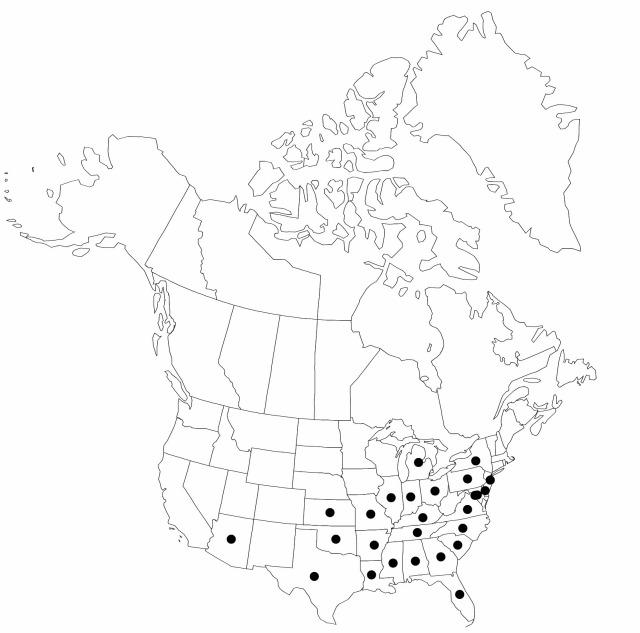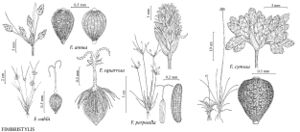Fimbristylis annua
in J. J. Roemer et al., Syst. Veg. 2: 95. 1817.
Plants annual, cespitose, 5–50 cm, base soft; rhizomes absent. Leaves nearly distichous, 1/2 to equal length of culms; sheaths bristlyciliate apically, backs glabrous or hirtellous; ligule present, complete; blades narrowly linear, 1–1.5(–2) mm wide, flat to shallowly involute, margins ciliate-scabrid, adaxial and abaxial surfaces glabrous or pubescent. Inflorescences: anthelae simple or compound, mostly open, diffuse, ascending-branched, longer than broad; scapes slender, 1 mm thick, angular; proximalmost involucral bract longer or shorter than anthela. Spikelets tan to brown or redbrown, ovoid to lance-ovoid, 3–8 mm; fertile scales broadly oblong to ovate, 2 mm, acute to obtuse-angled, smooth, midrib reaching apex or excurrent as mucro. Flowers: stamens 1(–2); styles 2-fid, flat, fimbriate. Achenes white to brown, often iridescent, lenticular or obovoid to pyriform-obovoid, 1 mm, cancellate, with 5–12 longitudinal ribs per side, alternating with as many rows of horizontally rectangular pits; warts of achene more usually distributed, or achene (rarely) smooth. 2n = 30.
Phenology: Fruiting summer–fall, all year southward.
Habitat: Various moist to wet substrates, often on exposed, recently disturbed soils around or in shallow temporary pools in outcrops, in savannas, fields, and paddies
Elevation: 0–1000 m
Distribution

Ala., Ariz., Ark., Del., D.C., Fla., Ga., Ill., Ind., Kans., Ky., La., Md., Mich., Miss., Mo., N.J., N.Y., N.C., Ohio, Okla., Pa., S.C., Tenn., Tex., Va., Mexico, West Indies, Bermuda, Central America, South America, Eurasia, Africa, Atlantic Islands, Indian Ocean Islands, Pacific Islands, Australia.
Discussion
The extensive, yet incomplete, synonymy above partly illustrates the polymorphic nature of Fimbristylis annua, there being many “stabilized” morphs in specialized habitats and much exchange of achenes mixed with grass seeds (particularly rice).
Selected References
None.
